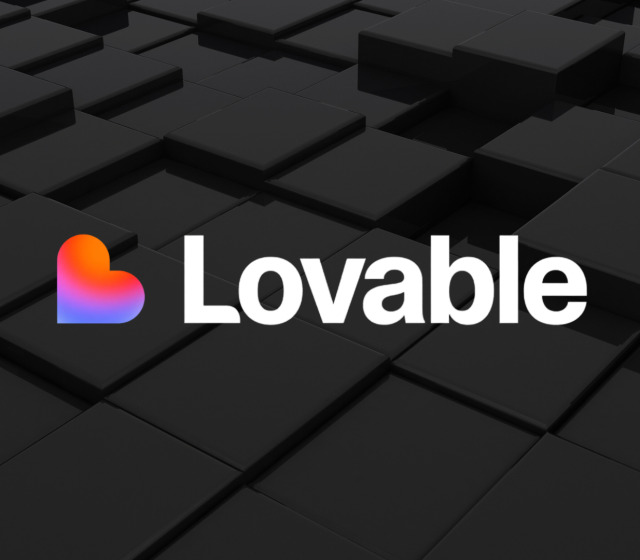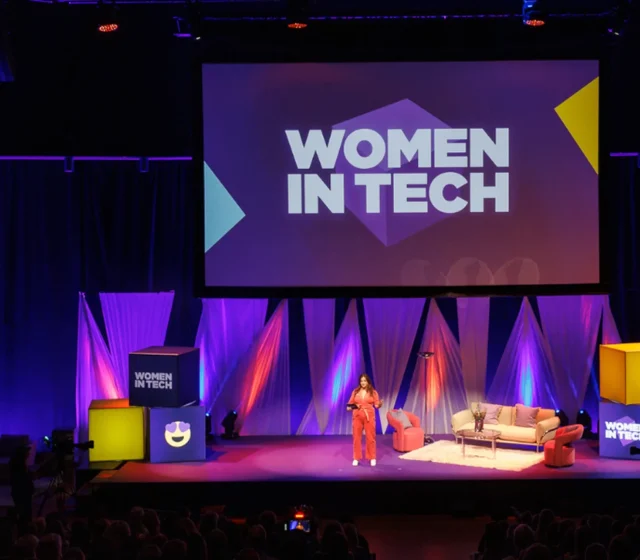MVVM, Clean Architecture and More: Building Maintainable Mobile Apps

In mobile development, speed is often everything, especially when working under tight deadlines and constantly shifting client requirements. But if you’ve ever tried to scale or maintain an app that was rushed to market you already know the cost of cutting corners with architecture.
At Fastdev, we develop native mobile apps for both iOS and Android. Regardless of project size, we’ve come to one clear conclusion: a clean, well-structured architecture is the best long-term investment for an app’s success.
In this post, we’ll share the architectural patterns and principles we use every day to build mobile apps that are scalable, testable, and maintainable
Why Architecture Matters
Mobile apps are never static. New features get added, product directions shift, user bases grow and so does the codebase. Without a clear architecture, even a small app can quickly descend into chaos.
From our experience, a thoughtful structure results in:
- lower long-term maintenance costs for clients;
- clear separation of concerns;
- faster onboarding of new developers;
- easier testing and debugging
According to a Forbes article, developers spend over 30% of their time dealing with technical debt. Introducing a clean and well-organized architecture from day one significantly reduces this burden in the future
The Core Architectures We Use
MVVM (Model–View–ViewModel)
We use MVVM as the foundational architecture for most of our apps. The Model–View–ViewModel pattern (MVVM) is widely adopted in both iOS and Android development. It separates the UI (View) from business logic (ViewModel), with the Model representing the data source. This separation works well with both imperative UI frameworks (UIKit, Android View System) and declarative ones like SwiftUI and Jetpack Compose.
- on iOS, MVVM integrates naturally with Combine and SwiftUI. The ViewModel handles state and business logic, allowing the View to react to changes declaratively;
- on Android, Jetpack’s ViewModel along with LiveData or Kotlin StateFlow provides a robust reactive architecture
According to Google’s own guidelines, MVVM promotes modularity, code reuse, and easier unit testing
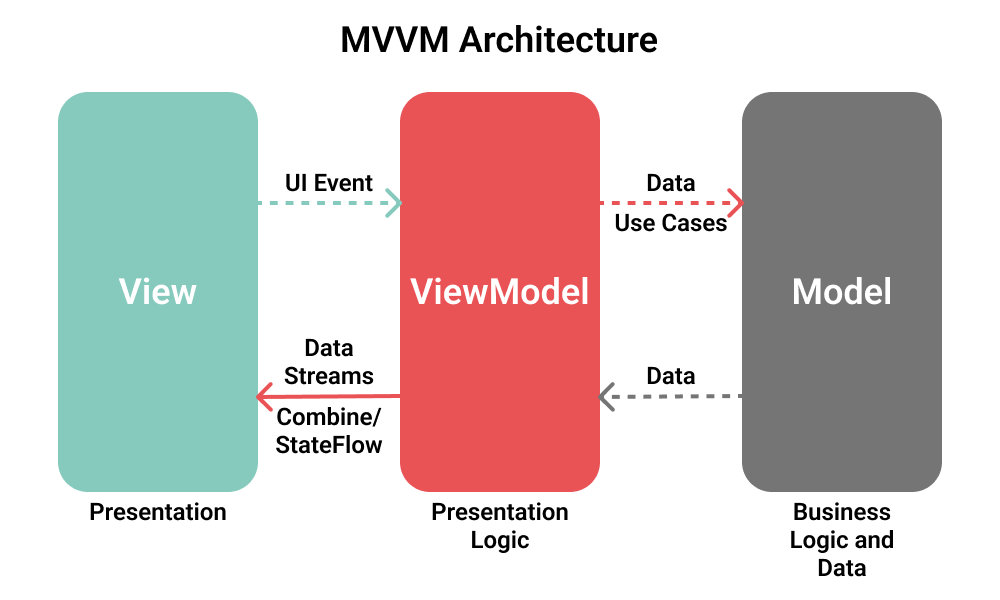
Why do we love MVVM?
It promotes testable, isolated components and aligns well with modern declarative UI frameworks
Clean Architecture
Clean Architecture takes it a step further by clearly defining layers:
- UI Layer – Screens, ViewModels;
- Domain Layer – Use Cases (business logic);
Data Layer – Repositories, local/remote data sources
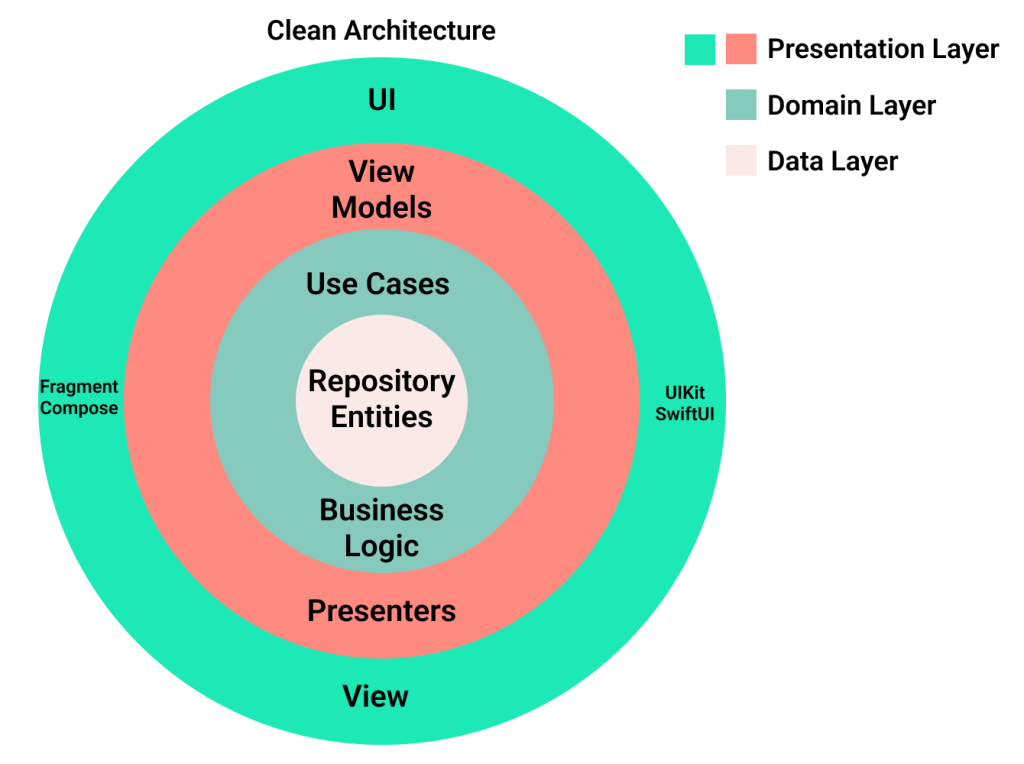
Each layer has a single responsibility and depends only on abstractions but not on concrete implementations. This makes it easy to modify or replace a layer without affecting the rest of the app
Example: If your app moves from REST to GraphQL, only the Data Layer needs to change. The Domain and UI layers remain untouched
Other Supporting Patterns
- Coordinator Pattern (iOS) / Navigation Component (Android)
We separate navigation logic from UI components to keep view controllers and activities (fragments) clean - Dependency Injection (DI)
Tools like Swinject (iOS), and Hilt or Koin (Android) help us inject dependencies cleanly, simplifying testing and configuration
Real-World Example: Login Flow
Let’s take the login flow as an example to demonstrate how MVVM and Clean Architecture work in practice:
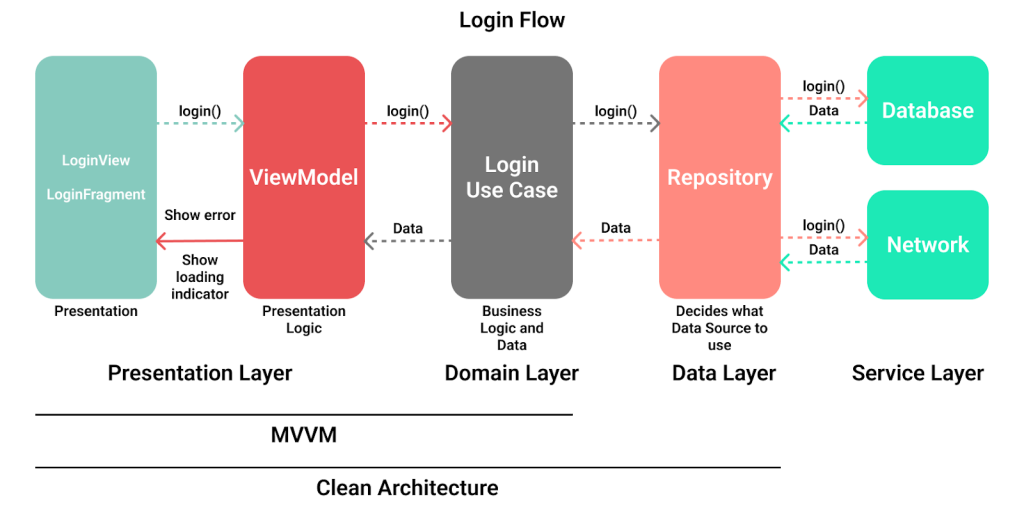
- UI Layer – loginView (SwiftUI) or LoginFragment (Jetpack Compose). The ViewModel contains a login() method and triggers the use case;
- Domain Layer – the Use Case handles business logic, maps data from the Data Layer to something usable in the UI, and decides which repository to use;
- Data Layer – the repository determines whether to use a cache or make a network request. The data source handles API calls via Alamofire (iOS) or Retrofit (Android)
Each component is testable in isolation and business logic stays out of the UI layer maintaining clean separation and architecture
How This Architecture Supports Testing
- Unit Tests – use сases and ViewModels are tested using mock repositories;
- UI Tests – snapshot and integration tests ensure behavior across layers;
- Mocking and DI – simplify test setup and allow comprehensive logic validation
This approach ensures stability and consistent behavior even as the app evolves
Our Internal Approach to Maintainability
To keep projects maintainable across the board we follow a few core practices:
- Modularization – we split functionality into independent modules (e.g., Auth, Profile, Search);
- Code Style – we enforce naming, formatting, and architectural standards via code reviews and linters;
- Platform Alignment – we use the same architectural structure across both iOS and Android. Making collaboration and cross-platform development more efficient
Why This Matters for Clients
When clients hire us, they’re not just getting screens and buttons – they’re getting a codebase designed to grow and evolve.
Our architecture-first approach helps clients:
- Scale faster – new developers onboard quickly;
- Adapt with confidence – new features or API changes don’t require rewrites;
- Save money – clean, testable code leads to fewer bugs and faster releases
Whether it’s an MVP or a complex platform we build apps with longevity in mind, because many of them go on to live long lives
Conclusion
Choosing the right architecture is one of the most important decisions in mobile development. MVVM and Clean Architecture provide a solid foundation for apps that not only work today, but remain robust and flexible tomorrow.
At Fastdev we’re committed to building mobile apps that are fast, reliable, and future-ready – and architecture is the heart of that promise.
Curious how we can help architect your next mobile app the smart way? Let’s talk.

Author / Daniil S. / iOS Developer, Mobile Tech Lead

Author / Eugeny G. / Android Developer

